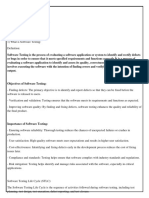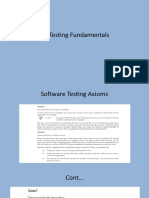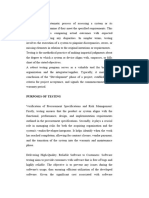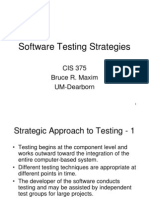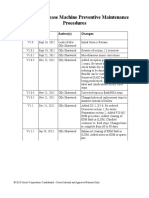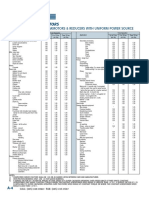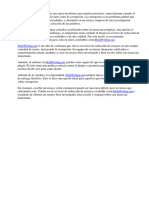Software Testing
Software Testing is the process of evaluating a software application or system to ensure that
it meets the specified requirements and performs as expected. It involves executing software
with the intention of finding defects and verifying its behavior against expected outcomes.
Here are some key aspects of software testing:
1. Testing Basics:
- Test Objective: Defining the purpose and goal of the testing effort.
- Test Environment: Setting up the necessary hardware, software, and network
configurations for testing.
- Test Execution: Running tests and analyzing results to identify defects.
- Defect Management: Capturing, reporting, and tracking defects found during testing.
- Test Completion Criteria: Establishing conditions that must be met to consider testing
complete.
2. Guidelines of Testing:
- Exhaustiveness: Designing test cases to cover different scenarios and combinations of
inputs.
- Independence: Ensuring that tests are not dependent on each other and can be executed
individually.
- Reproducibility: Tests should yield consistent results when repeated.
- Traceability: Linking test cases to requirements and tracking their coverage.
- Automation: Using automated tools and frameworks to enhance testing efficiency and
accuracy.
3. Characteristics of Software Tests:
- Correctness: Tests should verify the correctness of the software against specified
requirements.
- Reliability: Tests should consistently produce accurate results.
- Efficiency: Tests should be executed in a timely manner, utilizing available resources
efficiently.
- Effectiveness: Tests should identify defects and provide useful information about the
software's behavior.
- Maintainability: Tests should be easily maintained and updated as the software evolves.
4. Test Plan and Test Case:
- Test Plan: A document that outlines the approach, objectives, and scope of testing activities
for a particular software project. It includes information about test objectives, test strategies,
test schedules, resources, and deliverables.
- Test Case: A specific set of test inputs, execution conditions, and expected results
designed to validate a particular aspect of the software. Test cases are derived from test
scenarios and are used to execute tests systematically.
Effective software testing is crucial to ensuring the quality, reliability, and performance of
software applications. It helps identify defects early in the development process, reducing
costs and improving the overall user experience.
Harshit 9801907094
� Software Testing
The levels/types of software testing can be categorised into four main levels:
1. Unit Testing: Unit testing focuses on testing individual units or components of software in
isolation. A unit can be a function, method, or a small module. The purpose of unit testing is
to ensure that each unit functions correctly and meets the specified requirements. Unit tests
are typically written and executed by developers and can be automated using testing
frameworks. Unit testing helps identify defects early and facilitates easier debugging and
maintenance.
2. Integration Testing: Integration testing verifies the proper interaction and integration
between different components or modules of the software. It tests the interfaces and data
flow between these components and ensures that they work together as intended.
Integration testing can be performed at various levels, such as integration between modules,
subsystems, or external systems. The goal is to identify any issues or defects that may arise
due to the interaction between these components.
3. System Testing: System testing validates the entire software system as a whole. It
verifies that all integrated components work together seamlessly and meet the specified
requirements. System testing is performed on a complete, integrated system in an
environment that closely resembles the production environment. It focuses on testing system
behavior, performance, security, reliability, and other quality attributes. System testing helps
ensure that the software functions correctly from end to end and meets user expectations.
4. Acceptance Testing: Acceptance testing is the final level of testing and is conducted to
determine whether the software meets the requirements and is ready for deployment. It is
performed by the end-users or stakeholders to validate the software against the acceptance
criteria defined during the requirements phase. Acceptance testing can take different forms,
such as user acceptance testing (UAT) and business acceptance testing (BAT). The
objective is to ensure that the software meets the user's needs, is usable, and satisfies the
business objectives.
It's important to note that these levels of testing are not necessarily sequential and can
overlap or be performed iteratively depending on the development process and project
requirements. Each level serves a specific purpose and contributes to ensuring the overall
quality and reliability of the software.
By conducting testing at multiple levels, software development teams can detect defects and
issues at different stages, leading to better-quality software and improved user satisfaction.
Harshit 9801907094
� Software Testing
Testing techniques can be broadly categorized into three main types: white box testing,
black box testing, and gray box testing. These techniques are used to test software
applications from different perspectives and uncover defects in various ways. Let's explore
each technique:
1. White Box Testing:White box testing, also known as clear box testing or structural
testing, focuses on the internal structure and logic of the software. Testers have access to
the source code, architecture, and design details of the application. This technique aims to
ensure that all code paths and branches are executed and that the software functions
correctly according to its internal implementation. It includes testing methods such as
statement coverage, branch coverage, path coverage, and condition coverage. White box
testing is typically performed by developers and requires knowledge of programming and the
software's internals.
Advantages of White Box Testing:
- It can uncover issues related to code logic, flow, and data handling.
- It helps achieve high code coverage and ensures comprehensive testing of internal
components.
- It allows for efficient identification and debugging of defects.
2. Black Box Testing: Black box testing focuses on testing the software from an external
perspective without any knowledge of its internal structure or implementation details. Testers
only have access to the software's specifications, requirements, and interfaces. This
technique tests the functionality and behavior of the software, primarily based on inputs and
expected outputs. Test cases are designed to cover various scenarios, boundary conditions,
and error conditions. Black box testing can be performed by testers who do not require
programming knowledge.
Advantages of Black Box Testing:
- It ensures that the software meets the specified requirements and performs as expected.
- It simulates real-user scenarios and validates the software's behavior from a user's
perspective.
- It can uncover issues related to incorrect functionality, usability, and compatibility.
3. Gray Box Testing: Gray box testing is a combination of white box and black box testing
techniques. Testers have limited knowledge of the internal workings of the software, such as
high-level design or selected implementation details. Gray box testing allows for a more
comprehensive approach by leveraging both internal and external perspectives. Testers can
use their knowledge of the system's internals to design test cases that target specific areas
or functionalities. This technique is useful when the internal details are necessary to guide
testing effectively.
Advantages of Gray Box Testing:
- It combines the benefits of both white box and black box testing techniques.
- Testers can target critical areas for testing based on their understanding of the system's
internals.
- It allows for a better balance between code coverage and requirements coverage.
Harshit 9801907094
� Software Testing
The choice of testing technique depends on the goals, requirements, and available
information about the software. Typically, a combination of these techniques is employed to
achieve comprehensive testing coverage and ensure the software's quality and reliability.
Harshit 9801907094


